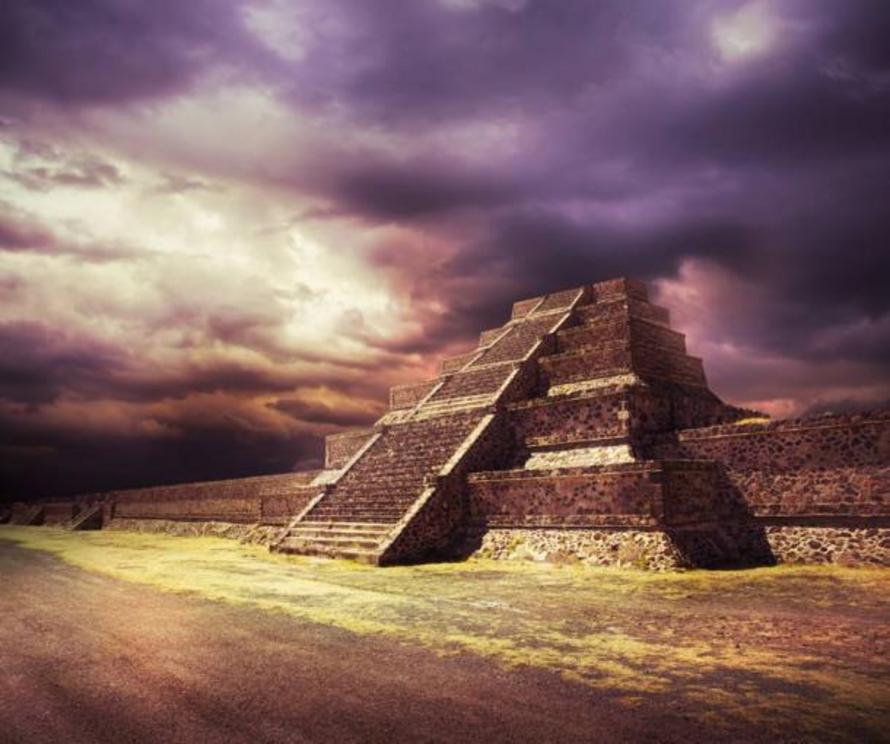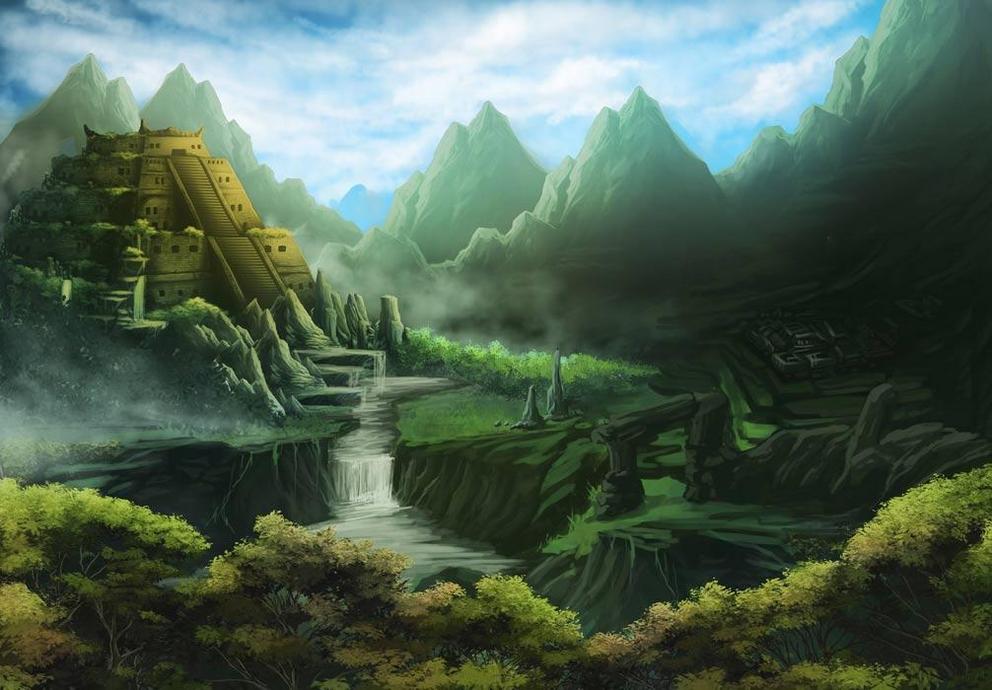The lost city of Aztlan – legendary homeland of the Aztecs
Artist’s representation of an Aztec temple in a mystery land. Aztlan is the Aztec’s legendary homeland.
Is Aztlan the ancient homeland of the great Aztec civilization, or is it just a mythical land described in legends?
The Aztec people of Mexico created one of the most important empires of the ancient Americas. While much is known about their empire located where today’s Mexico City can be found, less is known about the very start of the Aztec culture. Many consider the missing island of Aztlan to be the ancient homeland where the Aztec people began to form as a civilization prior to their migration to the Valley of Mexico.
Some believe it is a mythical land , similar to Atlantis or Camelot, which will live on through legend but will never be found in physical existence. Others believe it to be a true, physical location that will someday be identified. Searches for the land of Aztlan have spanned from Western Mexico all the way to the deserts of Utah in hopes of finding the legendary island. However, these searches have been fruitless, as the location – and existence – of Aztlan remain a mystery.
 Photo composite of an Aztec pyramid, not a real place.
Photo composite of an Aztec pyramid, not a real place.
The Seven Tribes at Chicomoztoc
The formation of civilization at Aztlan comes from legend. According to Nahuatl legend, there were seven tribes that once lived at Chicomoztoc – “the place of the seven caves.” These tribes represented the seven Nahua groups: Acolhua, Chalca, Mexica, Tepaneca, Tlahuica, Tlaxcalan, and Xochimilca (different sources provide variations on the names of these groups).
The seven groups, being of similar linguistic groups, left their respective caves and settled as one group near Aztlan. According to some accounts, the seven groups’ arrival at Aztlan was preceded by the arrival of a group known as the Chichimecas, who were considered to be less civilized than the seven Nahua groups. The Mexica were the last group to travel to Aztlan, and may have been slowed down due to a lengthy drought between 1100 and 1300 AD.
 This unusual 1704 map, drawn by Giovanni Francesco Gemelli Careri, is the first published representation of the legendary Aztec migration from Aztlan, a mysterious paradise somewhere to the northwest of Mexico, to Chapultepec Hill, currently Mexico City.
This unusual 1704 map, drawn by Giovanni Francesco Gemelli Careri, is the first published representation of the legendary Aztec migration from Aztlan, a mysterious paradise somewhere to the northwest of Mexico, to Chapultepec Hill, currently Mexico City.
Was Aztlan a Paradise or Land of Tyranny?
The word Aztlan means “the land to the north; the land from whence we, the Aztecs, came.” It is said that eventually the people who inhabited Aztlan became known as the Aztecs, who then migrated from Aztlan to the Valley of Mexico. In some tales, Aztlan is viewed as a land of paradise for all inhabitants.
In the Codex Aubin , Aztlan was a place where the Aztecs were subject to the Azteca Chicomoztoca - the tyrannical elite. To escape the Chicomoztoca, the Aztecs fled Aztlan, led by their priest . In the legend, the god Huitzilopochtli told them they could not use the name Azteca, and they would be known as Mexica. The Aztec migration from Aztlan to Tenochtitlán is a very important piece of Aztec history. It began on May 24, 1064, which was the first Aztec solar year.
 The Mexica depart from Aztlán. From the 16th Century Codex Boturini. Created by an unknown Aztec hand in the 16th century.
The Mexica depart from Aztlán. From the 16th Century Codex Boturini. Created by an unknown Aztec hand in the 16th century.
Aztlan was an Island on a Lake
Although Aztlan has never been physically identified, it has been described as an island. Rather than an island in the sea, it is an island upon a lake. Scholars have made many attempts to locate Aztlan, in hopes of finding the place where the Aztecs, later known as Mexica, originated.
Some have argued that the search for Atlantis and the search for Aztlan are one and the same, as these are simply two different names for the same land. However, this has been disputed, and many scholars searching for Aztlan believe it to be a separate land from the lost city of Atlantis .
One big mystery surrounding Aztlan is exactly how far north the area would have been located. With searches extending all the way up into Utah, it is possible that the Aztecs did not originate in Mexico at all, but that their culture was formed in an area that is now the United States prior to their migration to the area now known as the Valley of Mexico.
Some have argued that if this were true descendants of the Aztecs who are in the United States today may try to assert that they are not undocumented migrants but descendants of the Aztecs who are merely returning to their homeland.
 Chicomoztoc — the place of the seven caves. The mythical origin of the "nahuatlaca" tribes. From the "Historia Tolteca chicimeca". A postcortesian codex from 1550.
Chicomoztoc — the place of the seven caves. The mythical origin of the "nahuatlaca" tribes. From the "Historia Tolteca chicimeca". A postcortesian codex from 1550.
The Search for Aztlan
Although many have searched in hopes of finding Aztlan, archaeologists do not believe that its discovery will yield much in terms of ruins or artifacts. Finding Aztlan will offer a glimpse into the history of the Aztecs and where they originated, although it is agreed that where the Aztecs originated is not nearly as important as their migration to the Valley of Mexico and the events that occurred thereafter.
There are three methodological problems that arise when trying to determine where Aztlan was located. The first is known as “stretching.” It is likely that the Aztec civilization did not migrate directly from Aztlan to the Valley of Mexico, as this would have been a very long direct journey. Instead, it is likely that they zig-zagged as they traveled, making stops that would have lasted for various durations. It may be difficult to differentiate between a temporary destination and the duration of the entire journey.
 An ancient temple in mystical light. Will the legendary city of Aztlan ever be found?
An ancient temple in mystical light. Will the legendary city of Aztlan ever be found?
The second problem is known as “layering,” which recognizes that there is likely to have been more than one migration from North to South, and it is difficult to determine exactly which migration could be associated with Aztlan. The third problem is known as “folding.” This problem arises from the fact that there may have been migration back and forth, from north to south, and then from south to north again.
These three methodological problems intensify the difficulty in establishing whether Aztlan was a real location where the Aztecs originated, or if it was merely a legendary place that is symbolic of the Aztecs.
To this day, the actual existence of an island known as Aztlan has not been confirmed. Many have searched for the land, in hopes of having a better understanding of where the Aztecs came from and perhaps a better understanding of ancient Mexican history . However, like other lost cities, it is not clear whether Aztlan will ever be found.
Perhaps it once was an island, which has since sunk to the bottom of the lake, or it has somehow been altered or destroyed. Perhaps it is a land that does not exist in a physical sense, and was a creation of legendary tales explaining where the Aztecs originated. For now, it remains a legendary place where the Aztecs formed and became a powerful civilization before migrating to what is now known as Mexico City.
 Representation of Cuauhtémoc, the last tlatoani (leader of the Aztecs).
Representation of Cuauhtémoc, the last tlatoani (leader of the Aztecs).

